Pioneer AVIC-X850BT, AVIC-X8510BT, AVIC-X950BH, AVIC-Z150BH Operating Manual
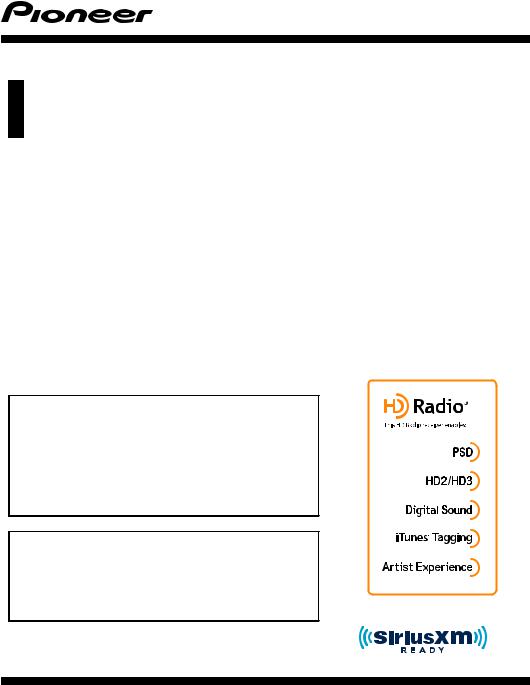
Operation Manual
MULTIMEDIA NAVIGATION RECEIVER
AVIC-Z150BH
AVIC-X950BH
AVIC-X850BT
AVIC-X8510BT
Notice to all users:
This software requires that the navigation system is properly connected to your vehicle’s parking brake and depending on your vehicle, additional installation may be required. For more information, please contact your Authorized Pioneer Electronics retailer or call us at (800) 421-1404.
Be sure to read Important Information for the User first!
Important Information for the User includes the important information that you must understand before using this navigation system.
English
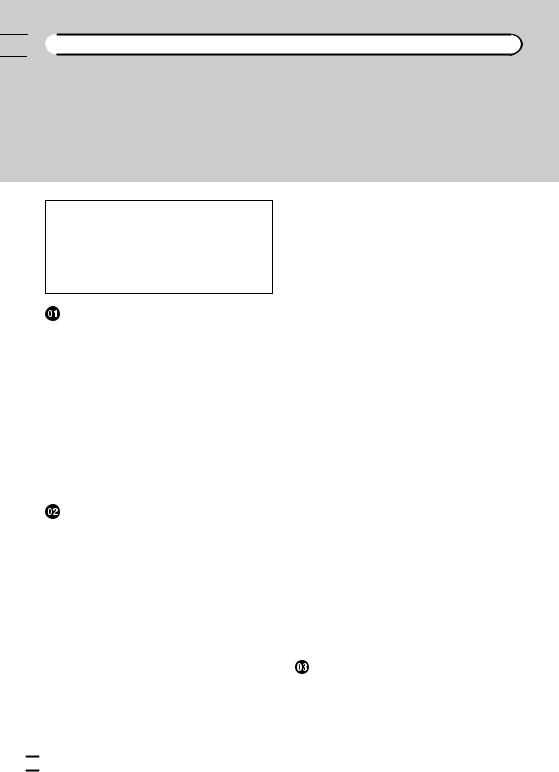

 Contents
Contents
Thank you for buying this Pioneer product.
Please read through these instructions so you will know how to operate your model properly. After you have finished reading the instructions, keep this document in a safe place for future reference.
 Important
Important
The screens shown in the examples may differ from actual screens, which may be changed without notice for performance and function improvements.
Introduction |
|
Manual overview 9 |
|
– |
How to use this manual 9 |
– |
Conventions used in this manual 9 |
– |
Terms used in this manual 9 |
Notice regarding video viewing |
10 |
|
|
|||
Notice regarding DVD-Video viewing |
10 |
|
||||
Notice regarding MP3 file usage |
10 |
|
|
|||
iPod compatibility 10 |
|
|
|
|
||
Map coverage |
11 |
|
|
|
|
|
Protecting the LCD panel and screen |
11 |
|||||
Notes on internal memory 11 |
|
|
|
|||
– |
Before removing the vehicle |
|
|
|||
|
battery |
11 |
|
|
|
|
– |
Data subject to erasure |
11 |
|
|
||
Basic operation |
|
|
|
|
||
Checking part names and functions |
12 |
|
||||
Protecting your product against theft |
14 |
|||||
– |
Removing the detachable |
|
|
|
||
|
faceplate |
14 |
|
|
|
|
– |
Attaching the detachable faceplate |
15 |
||||
Adjusting the LCD panel angle |
15 |
|
|
|||
Inserting and ejecting a disc |
15 |
|
|
|
||
– |
Inserting a disc (for AVIC-Z150BH) |
15 |
||||
– |
Ejecting a disc (for AVIC-Z150BH) |
16 |
||||
– |
Inserting a disc (for AVIC-X950BH, |
|
||||
|
AVIC-X850BT and AVIC-X8510BT) |
16 |
||||
– |
Ejecting a disc (for AVIC-X950BH, AVIC- |
|||||
|
X850BT and AVIC-X8510BT) |
16 |
|
|
||
Inserting and ejecting an SD memory |
|
|
||||
card 16 |
|
|
|
|
|
|
–Inserting an SD memory card (for AVICZ150BH) 16
–Ejecting an SD memory card (for AVICZ150BH) 17
–Inserting an SD memory card (for AVICX950BH, AVIC-X850BT and AVICX8510BT) 17
–Ejecting an SD memory card (for AVICX950BH, AVIC-X850BT and AVICX8510BT) 18
Connecting and disconnecting an iPod |
18 |
|
– |
Connecting your iPod 18 |
|
– |
Disconnecting your iPod 20 |
|
Plugging and unplugging a USB storage |
|
|
device 20 |
|
|
– |
Plugging in a USB storage device |
20 |
– |
Unplugging a USB storage device |
21 |
Startup and termination 21
On first-time startup |
21 |
Regular startup 22 |
|
–A message about the map database 22
Demonstration images 22
Temporarily clearing the screen (navigation
system in standby mode) |
22 |
|
||||
How to use the navigation menu |
|
|||||
screens |
24 |
|
|
|
|
|
Shortcut Menu |
25 |
|
|
|
||
– |
Selecting the shortcut |
25 |
|
|||
– |
Removing a shortcut |
25 |
|
|||
Using the touch panel |
26 |
|
|
|||
– |
Using the common touch panel |
|
||||
|
keys |
26 |
|
|
|
|
– |
Operating list screens (e.g. POI |
|
||||
|
list) |
26 |
|
|
|
|
– |
Operating the on-screen keyboard |
26 |
||||
Swipe action |
27 |
|
|
|
||
– |
Swipe action list |
27 |
|
|
||
How to use the map |
|
|
|
|||
How to read the map screen |
31 |
|
||||
– |
Enlarged map of the intersection |
32 |
||||
–The display while driving on the freeway 33
Types of the road stored in the map database 33
 2
2 En
En

 Contents
Contents
Operating the map screen 33
– Scrolling the map to the position you want to see 33
–Viewing information about a specified location 34
Switching the view mode |
35 |
|
Switching the map orientation |
35 |
|
Displaying one-way street marks |
36 |
|
Displaying POI on the map |
36 |
|
–Displaying preinstalled POIs on the map 36
Registering a scale |
37 |
|
|
|
|
||
Searching for and selecting a location |
|
||||||
The basic flow of creating your route |
38 |
|
|||||
Searching for a location by address |
39 |
|
|||||
– |
Searching for a city name first |
39 |
|
||||
– |
Finding the location by specifying the |
||||||
|
house number |
40 |
|
|
|
|
|
– |
Searching by selected city history |
41 |
|||||
Setting up a route to your home |
|
41 |
|
|
|||
Searching for Points of Interest (POI) |
41 |
|
|||||
– |
Searching for a POI directly from the |
||||||
|
name of the facilities 42 |
|
|
|
|
||
– |
Searching for a nearby POI |
42 |
|
|
|||
– |
Searching for POIs around the |
|
|
||||
|
destination 42 |
|
|
|
|
||
– |
Searching for POIs around the city |
43 |
|||||
– |
Deleting the icons displayed after |
|
|||||
|
searching for a nearby POI |
44 |
|
|
|||
Selecting destination from stored |
|
|
|
||||
locations |
44 |
|
|
|
|
|
|
Selecting a location you searched for |
|
|
|||||
recently |
44 |
|
|
|
|
|
|
Searching for a location by coordinates |
45 |
||||||
After the location is decided |
|
|
|
|
|||
Setting a route to your destination |
46 |
|
|||||
– |
Displaying multiple routes |
46 |
|
|
|||
Checking and modifying the current |
|
||||||
route |
|
|
|
|
|
|
|
Displaying the route overview |
47 |
|
|
||||
Checking the current itinerary |
47 |
|
|
||||
Modifying the route calculation |
|
||
conditions 48 |
|
|
|
– |
Items that users can operate |
48 |
|
Editing waypoints 49 |
|
|
|
– |
Adding a waypoint |
49 |
|
– |
Deleting a waypoint |
49 |
|
– |
Sorting waypoints |
50 |
|
Skipping a waypoint 50 |
|
|
|
Using the demonstration guidance |
50 |
||
–Finishing the demonstration guidance 51
Canceling the route guidance 51
 Editing the data on the use of navigation
Editing the data on the use of navigation
function |
|
|
Registering and editing locations |
52 |
|
– |
Storing favorite locations 52 |
|
– |
Editing registered locations |
52 |
– |
Deleting a favorite location from the |
|
|
list 52 |
|
–Deleting the destination history from the list 53
Deleting learned routes |
54 |
Deleting track logs 54 |
|
Using traffic information |
|
Checking all traffic information 55 |
|
Checking traffic information on the |
|
route 56
How to read traffic information on the map 56
Setting an alternative route to avoid traffic congestion 56
– Checking for traffic congestion automatically 57
Selecting the preferred RDS-TMC service provider manually 57
 Registering and connecting a Bluetooth
Registering and connecting a Bluetooth
device |
|
Preparing communication devices |
58 |
Registering your Bluetooth devices |
58 |
–Searching for nearby Bluetooth devices 58
En  3
3


 Contents
Contents
– |
Pairing from your Bluetooth |
|
devices 62 |
– |
Deleting a registered device 65 |
Connecting a registered Bluetooth device manually 65
– Setting for priority connecting 66
 Using hands-free phoning
Using hands-free phoning
Displaying the phone menu 67
Making a phone call |
67 |
– Direct dialing |
67 |
–Calling a number in the phone book 68
– |
Dialing from the history |
69 |
|
|
||
– |
Redialing a call |
69 |
|
|
|
|
– |
Dialing a favorite location |
69 |
|
|
||
– |
Dialing a facility’s phone number |
70 |
||||
Receiving a phone call |
70 |
|
|
|
|
|
– |
Answering an incoming call |
70 |
|
|||
Transferring the phone book |
71 |
|
|
|||
– |
Deleting registered contacts |
72 |
|
|||
– |
Deleting the history information |
72 |
||||
Changing the phone settings |
|
73 |
|
|
||
– |
Editing the device name |
73 |
|
|
||
– |
Editing the password |
73 |
|
|
||
– |
Stopping Bluetooth wave |
|
|
|
||
|
transmission 74 |
|
|
|
|
|
– |
Answering a call automatically 74 |
|||||
–Setting the automatic rejection function 74
Notes for hands-free phoning 75
 Basic operations of the AV source
Basic operations of the AV source
Displaying the AV operation screen 76
– Selecting a source |
76 |
|
Turning off the AV source |
76 |
|
AV source plate display |
77 |
|
Using the radio |
|
|
Starting procedure |
78 |
|
Reading the screen |
78 |
|
Using the touch panel keys 78
–Storing and recalling broadcast frequencies 79
–Storing the strongest broadcast frequencies 79
Using advanced functions |
80 |
|
– Tuning in strong frequencies 80 |
||
Operating by hardware buttons 80 |
||
HD Radio™ reception |
|
|
HD Radio stations |
81 |
|
Starting procedure |
81 |
|
Reading the screen |
81 |
|
Using the touch panel keys |
82 |
|
– Storing and recalling broadcast |
||
frequencies |
84 |
|
–Storing the strongest broadcast frequencies 84
Storing song information to an iPod (iTunes
Tagging) 84 |
|
|
|
|
Using advanced functions |
85 |
|
|
|
– Tuning in strong frequencies |
85 |
|||
– Switching the seek mode |
85 |
|
||
– Switching the reception mode |
85 |
|||
Operating by hardware buttons |
85 |
|
||
Playing audio CDs |
|
|
|
|
Starting procedure |
86 |
|
|
|
Reading the screen |
86 |
|
|
|
Using the touch panel keys |
87 |
|
|
|
Operating by hardware buttons |
87 |
|
||
Playing music files on ROM |
|
|
||
Starting procedure |
88 |
|
|
|
Reading the screen |
88 |
|
|
|
Using the touch panel keys |
89 |
|
|
|
Operating by hardware buttons |
89 |
|
||
Playing a DVD-Video |
|
|
|
|
Starting procedure |
90 |
|
|
|
Reading the screen |
90 |
|
|
|
Using the touch panel keys |
91 |
|
|
|
– Resuming playback (Bookmark) 92
–Searching for a specific scene and starting playback from a specified
|
time 92 |
– |
Direct number search 93 |
– |
Operating the DVD menu 93 |
 4
4 En
En

 Contents
Contents
– |
Using the DVD menu by touch panel |
|||||||
|
keys |
93 |
|
|
|
|
|
|
– |
Frame-by-frame playback |
93 |
|
|
||||
– |
Slow motion playback |
94 |
|
|
||||
– |
Changing the wide screen mode |
94 |
||||||
Operating by hardware buttons |
94 |
|
||||||
Playing a DivX video |
|
|
|
|
|
|||
Starting procedure |
95 |
|
|
|
|
|
||
Reading the screen |
95 |
|
|
|
|
|
||
Using the touch panel keys |
95 |
|
|
|
||||
– |
Frame-by-frame playback |
96 |
|
|
||||
– |
Slow motion playback |
97 |
|
|
||||
– |
Starting playback from a specified |
|
||||||
|
time |
97 |
|
|
|
|
|
|
– |
Changing the wide screen mode |
97 |
||||||
Playing DivX® VOD content |
98 |
|
|
|||||
Operating by hardware buttons |
98 |
|
||||||
DVD-Video or DivX setup |
|
|
|
|
||||
Displaying DVD/DivX® Setup menu |
99 |
|
||||||
Setting the top-priority languages |
99 |
|
||||||
Setting the angle icon display |
99 |
|
|
|||||
Setting the aspect ratio |
100 |
|
|
|
|
|||
Setting the parental lock |
100 |
|
|
|
||||
–Setting the code number and level 100
Setting the auto play 101 |
|
Setting the subtitle file for DivX |
101 |
Language code chart for DVDs |
102 |
 Playing music files (from USB or SD)
Playing music files (from USB or SD)
Starting procedure |
103 |
Reading the screen |
103 |
Using the touch panel keys (Music) 104 Operating by hardware buttons 104
 Playing video files (from USB or SD)
Playing video files (from USB or SD)
Starting procedure |
105 |
Reading the screen |
105 |
Using the touch panel keys (Video) 106
–Searching for a specific scene and starting playback from a specified time 107
Operating by hardware buttons 107
Using an iPod (iPod) |
|
|
Starting procedure |
108 |
|
Reading the screen |
109 |
|
Using the touch panel keys 110 |
|
|
Changing the wide screen mode |
111 |
|
Operating by hardware buttons |
112 |
|
 Streaming Pandora® and using Aha Radio
Streaming Pandora® and using Aha Radio
Information for compatibility of connected devices 113
–For AVIC-Z150BH and AVICX950BH 113
–For AVIC-X850BT and AVICX8510BT 113
Starting procedure |
114 |
|
|
|
|
||
– |
For iPhone with 30-pin connector |
|
|||||
|
users |
114 |
|
|
|
|
|
– |
For iPhone with Lightning connector |
||||||
|
users |
114 |
|
|
|
|
|
– |
For smartphone users |
115 |
|
||||
Streaming Pandora® |
116 |
|
|
|
|
||
– |
Reading the screen |
116 |
|
|
|||
– |
Using the touch panel keys |
117 |
|
||||
– |
Operating by hardware buttons |
117 |
|||||
Using Aha Radio 118 |
|
|
|
|
|||
– |
Reading the screen |
118 |
|
|
|||
– |
Using the touch panel keys |
119 |
|
||||
– |
Functions coupled with Aha Radio and |
||||||
|
the navigation system |
120 |
|
||||
Using the Bluetooth audio player |
|
||||||
Starting procedure |
121 |
|
|
|
|
||
Reading the screen |
121 |
|
|
|
|
||
Using the touch panel keys |
|
122 |
|
|
|||
Operating by hardware buttons |
123 |
|
|||||
Using the SiriusXM tuner |
|
|
|
||||
Introducing SiriusXM tuner operations |
124 |
||||||
–To subscribe to the SiriusXM Satellite Radio service 124
Starting procedure |
124 |
Reading the screen |
124 |
Using the touch panel keys 125
En  5
5


 Contents
Contents
– |
Storing broadcast channels |
127 |
|
– |
Selecting a SiriusXM channel |
|
|
|
directly 127 |
|
|
– |
Selecting a channel from the list 127 |
||
– |
Using the “Replay™” function |
127 |
|
– |
Using the Tune Scan™ |
128 |
|
Using advanced functions 128 |
|
||
– |
Setting the Tune Start™ |
128 |
|
– |
Setting the parental lock |
128 |
|
–Using the Content Alerts function (such as Song Alerts, Artist Alerts and Game Alerts) 129
Storing song information to an iPod (iTunes
Tagging) |
130 |
|
Operating by hardware buttons |
130 |
|
Using AV input |
|
|
Reading the screen 131 |
|
|
Using AV1 |
131 |
|
Using AV2 |
131 |
|
Using the touch panel keys 131 |
|
|
Changing the wide screen mode |
132 |
|
 Using AppRadio Mode
Using AppRadio Mode
Information for compatibility of connected devices 133
–For AVIC-Z150BH and AVICX950BH 133
–For AVIC-X850BT and AVICX8510BT 134
Starting procedure |
134 |
|
||
– |
For iPhone with 30-pin connector |
|||
|
users |
134 |
|
|
– |
For iPhone with Lightning connector |
|||
|
users |
135 |
|
|
– |
For smartphone users |
135 |
||
Using the keyboard |
137 |
|
||
Using the sound mix function |
137 |
|||
Other functions 138 |
|
|||
–Displaying the image of your application (iPhone with 30-pin connector) 138
–Displaying the image of your application (iPhone with Lightning
connector) 138
–Displaying the image of your application (smartphone) 139
Customizing preferences |
|
Displaying the information screen |
140 |
Checking the connections of leads |
140 |
Checking sensor learning status and driving
status 141 |
|
– Clearing status |
142 |
Checking the device number 142 |
|
Checking the version information 142 |
|
Registering your home |
142 |
Displaying the adjustment and correction screen 143
Switching the muting/attenuation timing 143
Switching the muting/attenuation level 144 Setting the Volume for Guidance and
Phone 144
Correcting the current location 144 Switching the road on which you are
driving 145
Displaying the screen for navigation function settings 145
– Changing the road color 145
–Setting the scroll-Locked 2D (Normal) View 145
– |
Displaying the 3D landmarks |
146 |
– |
Setting the detailed city map |
146 |
–Setting the barrier graphic for the city map 146
–Setting the map color change between
|
day and night |
147 |
– |
Displaying the track log 147 |
|
– |
Deleting the track log |
|
|
automatically |
147 |
– |
Setting the current street name |
|
|
display 148 |
|
– |
Setting the criteria of route |
|
|
calculation 148 |
|
– |
Setting the use of toll roads 148 |
|
 6
6 En
En

 Contents
Contents
– |
Setting the use of ferries |
148 |
– |
Setting video input 1 (AV1) |
157 |
||||
– Setting the route calculation by |
– |
Setting video input 2 (AV2) |
157 |
||||||
|
learning route 149 |
|
|
– |
Changing the screen size of SD/USB |
||||
– Setting the route calculation allowing |
|
video |
157 |
|
|
|
|||
|
for traffic congestion |
149 |
– Displaying your DivX VOD registration |
||||||
– Setting the route calculation allowing |
|
code |
157 |
|
|
|
|||
|
for time restrictions |
149 |
|
– Displaying your DivX VOD |
|
||||
– |
Setting the use of freeways 149 |
|
deregistration code |
158 |
|
|
|||
– Setting to select your route |
– |
Setting the iPod connection |
158 |
||||||
|
automatically using the auto reroute |
Displaying the screen for AV sound |
|||||||
|
function 150 |
|
|
settings |
158 |
|
|
|
|
– Displaying the distance and estimated |
– |
Using balance adjustment |
159 |
||||||
|
time 150 |
|
|
– |
Adjusting loudness |
159 |
|
|
|
– Setting the auto reroute function to |
– |
Using the equalizer |
159 |
|
|
||||
|
avoid traffic congestion |
150 |
– |
Adjusting source levels |
161 |
||||
– |
Setting the auto-zoom display 151 |
– |
Using the high pass filter |
162 |
|||||
– Changing the setting of the navigation |
– |
Using the subwoofer output |
162 |
||||||
|
interruption screen |
151 |
|
– |
Enhancing bass (Bass Booster) 162 |
||||
– |
Setting the App operation screen |
– |
Using sonic center control |
163 |
|||||
|
interruption |
151 |
|
Adjusting the equalizer curve automatically |
||||||||
– Changing the virtual speed of the |
(Auto EQ) |
163 |
|
|
|
|
||||||
|
vehicle |
151 |
|
|
– Before operating the Auto EQ |
|
|
|||||
– Changing the unit between km and |
|
function |
163 |
|
|
|
|
|||||
|
miles |
|
152 |
|
|
– |
Performing Auto EQ |
164 |
|
|
||
– Displaying the traffic notification |
Displaying the screen for app settings |
165 |
||||||||||
|
icon |
152 |
|
|
– Selecting the device connection |
|
||||||
Changing the view mode 152 |
|
|
method |
165 |
|
|
|
|
||||
Displaying the screen for system |
– Setting the keyboard language with |
|||||||||||
settings |
152 |
|
|
|
application for iPhone |
166 |
|
|
||||
– |
Selecting the language |
153 |
Setting the rear output |
167 |
|
|
||||||
– |
Setting the time difference 153 |
Adjusting the picture 167 |
|
|
|
|||||||
– Changing the preinstalled splash |
Selecting the video for rear display |
168 |
||||||||||
|
screen |
153 |
|
|
Replicating the settings |
169 |
|
|
||||
– Changing to the splash screen stored |
Using the rear view camera functions |
169 |
||||||||||
|
on the SD memory card |
154 |
– |
Setting for rear view camera |
170 |
|||||||
– Adjusting the response positions of the |
– |
Setting guidelines on the rear view |
||||||||||
|
touch panel (touch panel |
|
|
image |
170 |
|
|
|
|
|||
|
calibration) |
155 |
|
Other functions |
|
|
|
|
||||
– |
Setting the illumination color 155 |
|
|
|
|
|||||||
Setting the anti-theft function 172 |
|
|
||||||||||
– |
Displaying the icon for setting the rear |
|
|
|||||||||
– |
Setting the password |
172 |
|
|
||||||||
|
display output 156 |
|
|
|
||||||||
|
|
– |
Entering the password |
172 |
|
|
||||||
Displaying the screen for AV system |
|
|
||||||||||
– |
Deleting the password |
172 |
|
|
||||||||
settings |
156 |
|
|
|
|
|||||||
|
|
– |
Forgotten password 172 |
|
|
|||||||
|
|
|
|
|
|
|
|
|||||
En  7
7


 Contents
Contents
Restoring the navigation system to the
default or factory settings |
173 |
|
|||
– |
Restoring the default setting |
173 |
|||
– |
Restoring the navigation system to the |
||||
|
initial state |
173 |
|
|
|
– |
Setting items to be deleted |
174 |
|||
Appendix |
|
|
|
|
|
Troubleshooting |
176 |
|
|
|
|
Messages for navigation functions |
181 |
||||
Messages for AV functions |
182 |
|
|||
Messages for Bluetooth functions |
184 |
||||
Positioning technology |
185 |
|
|
||
– |
Positioning by GPS |
185 |
|
||
– |
Positioning by dead reckoning 185 |
||||
–How do GPS and dead reckoning work together? 185
Handling large errors 186
– When positioning by GPS is impossible 186
–Conditions likely to cause noticeable positioning errors 187
Route setting information |
189 |
|
– |
Route search specifications 189 |
|
Handling and care of discs |
189 |
|
– |
Built-in drive and care |
190 |
–Ambient conditions for playing a disc 190
Playable discs 190 |
|
|
– |
DVD-Video and CD |
190 |
– |
AVCHD recorded discs 191 |
|
– |
Playing DualDisc |
191 |
– |
Dolby Digital 191 |
|
Detailed information for playable media 191
– |
Compatibility 191 |
– |
Media compatibility chart 194 |
Bluetooth 198 |
|
SiriusXM Radio READY Logo 198
HD Radio™ Technology 198
SD and SDHC logo 198
WMA/WMV |
199 |
|
DivX |
199 |
|
AAC |
199 |
|
Android™ |
199 |
|
Detailed information regarding connected
iPod devices |
199 |
|
– |
iPod and iPhone 199 |
|
– |
Lightning |
200 |
– |
App Store |
200 |
–iOS 200
–iTunes 200
Using app-based connected content 200
–Pandora® 200
–Aha Radio 201 HDMI 201
MHL 201
Using the LCD screen correctly |
201 |
|
– |
Handling the LCD screen |
201 |
– |
Liquid crystal display (LCD) |
|
|
screen 201 |
|
– |
Maintaining the LCD screen 201 |
|
–LED (light-emitting diode) backlight 202
Display information |
203 |
|
|
– |
Destination menu |
203 |
|
– |
Phone menu 203 |
|
|
– |
Information menu |
203 |
|
– |
Edit/Settings menu |
204 |
|
– |
Data Edit menu |
204 |
|
– |
Navi Settings menu |
204 |
|
– |
AV Settings menu |
205 |
|
–Setting according to source menu 206
– |
App Settings menu 206 |
– |
System Settings menu 206 |
– |
Bluetooth Settings menu 207 |
Glossary 208
Specifications 211
 8
8 En
En

|
Chapter |
Introduction |
01 |
Manual overview
Before using this product, be sure to read Important Information for the User (a separate manual) which contains warnings, cautions, and other important information that you should note.
The screen examples shown in this manual are those for AVIC-Z150BH. The screens may vary according to the models.
How to use this manual
Finding the operation procedure for what you want to do
When you have decided what you want to do, you can find the page you need from the Contents.
Finding the operation procedure from a menu name
If you want to check the meaning of an item displayed on screen, you will find the necessary page from the Display information at the end of the manual.
Glossary
Use the glossary to find the meanings of terms.
Conventions used in this manual
Before moving on, take a few minutes to read the following information about the conventions used in this manual. Familiarity with these conventions will help you greatly as you learn how to use your new equipment.
!Buttons on your navigation system are described in ALL CAPITALS, BOLD lettering:
e.g.)
HOME button, MODE button.
!Menu items, screen titles, and functional components are described in bold with double quotation marks “ ”:
e.g.)
“Destination” screen or “Phone” screen
!Touch panel keys that are available on the screen are described in bold in brackets [ ]: e.g.)
[Destination], [AV Source].
!Extra information, alternatives and other notes are presented in the following format:
e.g.)
p If the home location has not been stored yet, set the location first.
!Functions of other keys on the same screen are indicated with # at the beginning of the description:
e.g.)
# If you touch [OK], the entry is deleted.
!References are indicated like this: e.g.)
= For details of the operations, refer to
How to use the navigation menu screens on page 24.
Terms used in this manual
“Front display” and “Rear display”
In this manual, the screen that is attached to the body of this navigation unit will be referred to as the “Front display”. Any additional screen that is commercially available and can be connected to this navigation unit will be referred to as the “Rear display”.
“Video image”
“Video image” in this manual indicates moving images of DVD-Video, DivX®, iPod, and any equipment that is connected to this system with an RCA cable, such as general-purpose AV equipment.
Introduction
En  9
9

Chapter
01  Introduction
Introduction
“External storage device (USB, SD)”
The SD memory card, SDHC memory card, microSD card, microSDHC card and USB memory device are collectively referred to as the “external storage device (USB, SD)”. If it indicates the USB memory only, it is referred to as the “USB storage device”.
“SD memory card”
satellite, cable and/or any other media), broadcasting/streaming via internet, intranets and/ or other networks or in other electronic content distribution systems, such as pay-audio or audio-on-demand applications. An independent license for such use is required. For details, please visit http://www.mp3licensing.com. 
The SD memory card, SDHC memory card, microSD card and microSDHC card are collectively referred to as the “SD memory card”.
“iPod”
In this manual, iPod and iPhone will be referred to as “iPod”.
Notice regarding video viewing
Remember that use of this system for commercial or public viewing purposes may constitute an infringement on the author’s rights as protected by the Copyright Law.
Notice regarding DVDVideo viewing
This item incorporates copy protection technology that is protected by U.S. patents and other intellectual property rights of Rovi Corporation. Reverse engineering and disassembly are prohibited.
Notice regarding MP3 file usage
Supply of this product only conveys a license for private, non-commercial use and does not convey a license nor imply any right to use this product in any commercial (i.e. revenuegenerating) real time broadcasting (terrestrial,
iPod compatibility
This product supports only the following iPod models and iPod software versions. Others may not work correctly.
Made for
!iPod touch (5th generation): iOS 6.0.1
!iPod touch (4th generation): iOS 6.0.1
!iPod touch (3rd generation): iOS 5.1.1
!iPod touch (2nd generation): iOS 4.2.1
!iPod touch (1st generation): iOS 3.1.3
!iPod classic 160GB (2009): Ver. 2.0.4
!iPod classic 160GB (2008): Ver. 2.0.1
!iPod classic 80GB: Ver. 1.1.2
!iPod nano (6th generation): Ver. 1.2
!iPod nano (5th generation): Ver. 1.0.2
!iPod nano (4th generation): Ver. 1.0.4
!iPod nano (3rd generation): Ver. 1.1.3
!iPhone 5: iOS 6.0.1
!iPhone 4S: iOS 6.0.1
!iPhone 4: iOS 6.0.1
!iPhone 3GS: iOS 6.0.1
!iPhone 3G: iOS 4.2.1
!iPhone: iOS 3.1.3
p You can connect and control an iPod compatible with this navigation system by using separately sold connector cables.
pOperation methods may vary depending on the iPod models and the software version of iPod.
pDepending on the software version of the iPod, it may not be compatible with this equipment.
For details about iPod compatibility with this navigation system, refer to the information on our website.
 10
10 En
En

|
Chapter |
Introduction |
01 |
This manual applies to the following iPod models.
iPod with 30-pin connector
!iPod touch 4th generation
!iPod touch 3rd generation
!iPod touch 2nd generation
!iPod touch 1st generation
!iPod classic 160GB
!iPod classic 80GB
!iPod nano 6th generation
!iPod nano 5th generation
!iPod nano 4th generation
!iPod nano 3rd generation
!iPhone 4S
!iPhone 4
!iPhone 3GS
!iPhone 3G
!iPhone
iPod with Lightning connector
!iPod touch 5th generation
!iPhone 5
Notes on internal memory
Before removing the vehicle battery
If the battery is disconnected or discharged, the memory will be erased and must be reprogrammed.
pSome data remains. Be sure to read Setting items to be deleted first.
=For details, refer to Setting items to be deleted on page 174.
Data subject to erasure
The information is erased by disconnecting the yellow lead from the battery (or removing the battery itself).
pSome data remains. Be sure to read Setting items to be deleted first.
=For details, refer to Setting items to be deleted on page 174.
Introduction
Map coverage
For details about the map coverage of this navigation system, refer to the information on our website.
Protecting the LCD panel and screen
pDo not expose the LCD screen to direct sunlight when this product is not used.
This may result in LCD screen malfunction due to the resulting high temperatures.
pWhen using a cellular phone, keep the antenna of the cellular phone away from the LCD screen to prevent disruption of the
video in the form of spots, colored stripes, etc.
pTo protect the LCD screen from damage, be
sure to touch the touch panel keys only with your finger and do so gently.
En  11
11
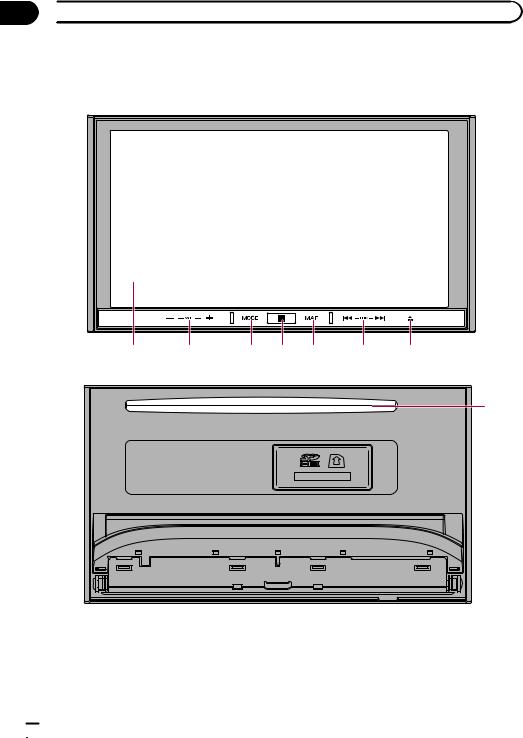
Chapter
02  Basic operation
Basic operation
Checking part names and functions
This chapter gives information about the names of the parts and the main features using the buttons.
AVIC-Z150BH (with the LCD panel closed)
1 |
2 |
3 |
4 |
5 |
6 |
7 |
AVIC-Z150BH (with the LCD panel open)
8
 9
9
 12
12 En
En
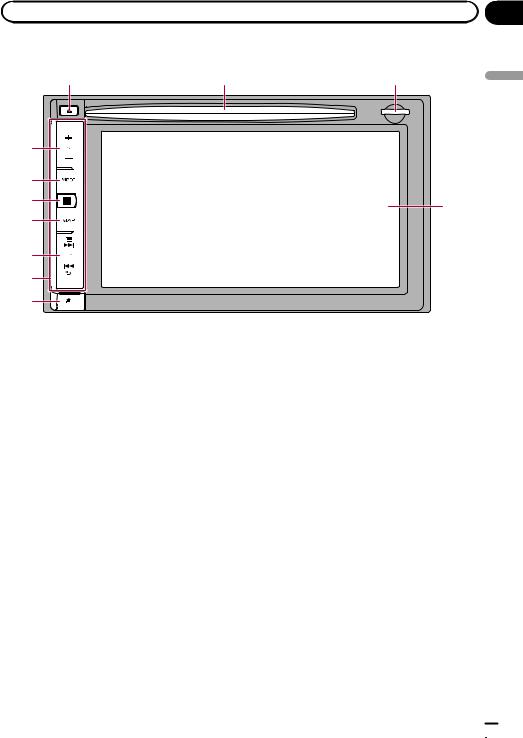
|
|
Chapter |
Basic operation |
|
02 |
AVIC-X950BH, AVIC-X850BT, and AVIC-X8510BT |
|
|
7 |
8 |
9 |
|
|
Basic |
2 |
|
operation |
3 |
|
|
4 |
|
1 |
|
|
|
5 |
|
|
6 |
|
|
a |
|
|
b |
|
|
1LCD screen
2VOL (+/–) button
Press to adjust the AV (Audio and Video) source volume.
3MODE button
!Press to switch the screen to the AV operation screen or the AppRadio Mode screen.
=For details of the operations, refer to
How to use the navigation menu screens on page 24.
!Press to switch between the AppRadio Mode screen and the AV operation screen.
=For details of the operations, refer to
How to use the navigation menu screens on page 24.
!Press and hold to display the “Picture Adjustment” screen.
=For details, refer to Adjusting the picture on page 167.
!Press and hold to display the touch panel calibration screen while the “Picture Adjustment” screen is displayed.
=For details, refer to Adjusting the response positions of the touch panel (touch panel calibration) on page 155.
4HOME button
!Press the HOME button to display the “Top Menu” screen while the map screen, the AV operation screen, or the application menu screen is displayed.
!Press to switch the application operation screen to the application menu screen.
=For details of the operations, refer to
How to use the navigation menu screens on page 24.
5MAP button
!Press to display the current location when the navigation screen (showing other than the current location) is displayed.
When the current location is displayed, the screen changes to the registered map scale. When the AV source screen is displayed, it switches to the current location screen.
=For details, refer to Registering a scale on page 37.
En  13
13
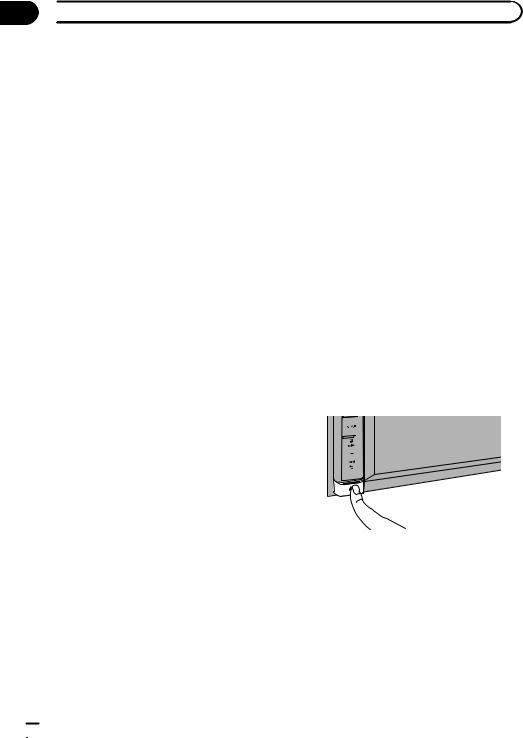
Chapter
02  Basic operation
Basic operation
!Press and hold to temporarily clear the screen regardless of whether it is the AV source, the current location screen or the AppRadio Mode screen.
=For details, refer to Temporarily clearing the screen (navigation system in standby mode) on page 22.
6TRK button
!Press to perform manual seek tuning, fast forward, reverse and track search controls.
!Press to perform the back and menu function of the Android device when you use the AppRadio Mode with an Android device.
7h button
8Disc-loading slot
Insert a disc to play.
=For details, refer to Inserting and ejecting a disc on page 15.
9SD card slot
=For details, refer to Inserting and ejecting an SD memory card on page 16.
aDetachable faceplate
b button
button
Press to remove the detachable faceplate from the navigation system.
=For details, refer to Removing the detachable faceplate on page 14.
Protecting your product against theft
p This function is available on AVIC-X950BH, AVIC-X850BT, and AVIC-X8510BT.
The detachable faceplate can be detached from the navigation system to discourage theft, as described below.
 CAUTION
CAUTION
!Do not expose the detachable faceplate to excessive shock or disassemble it.
!Never grip the buttons tightly or use force when removing or attaching.
!Keep the detachable faceplate out of reach of small children to prevent them from placing it in their mouths.
!After removing the detachable faceplate, keep it in a safe place so it is not scratched or damaged.
!Do not expose the detachable faceplate to direct sunlight and high temperatures.
!When removing or attaching the detachable faceplate, do so after turning off the ignition switch (ACC OFF).
Removing the detachable faceplate
pThe navigation system cannot be operated while the detachable faceplate is removed from the navigation system.
1 Press the  button.
button.
When you release your finger, the bottom of the detachable faceplate separates slightly from the navigation system.
 14
14 En
En
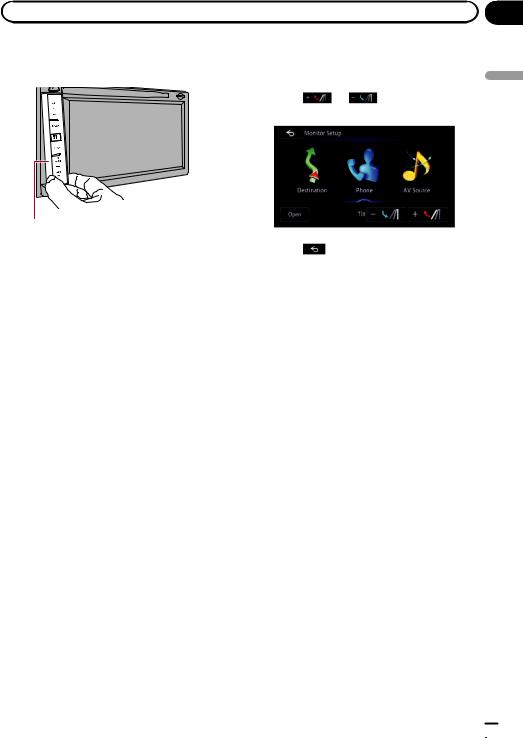
|
Chapter |
Basic operation |
02 |
2 Gently grip the bottom of the detachable faceplate and slowly pull it outward.
Detachable faceplate
Attaching the detachable faceplate
1Slide the detachable faceplate all the way into the navigation system.
Make sure the detachable faceplate is securely connected to the mounting hooks of the navigation system.
2Push the lower part of the detachable faceplate until you hear a click.
If you fail to successfully attach the detachable faceplate to the navigation system, try
again but be careful not to force it as the panel could be damaged.
Adjusting the LCD panel angle
pThis function is only available on AVICZ150BH.
 WARNING
WARNING
Keep hands and fingers clear of the unit when opening, closing, or adjusting the LCD panel. Be especially cautious of children’s hands and fingers.
 CAUTION
CAUTION
Do not open or close the LCD panel by force. This may cause a malfunction.
1 Press the h button.
The “Monitor Setup” screen appears.
2 |
Touch |
or |
operationBasic |
to adjust the |
|||
angle. |
|
|
|
3 |
Touch |
. |
|
pThe adjusted angle of the LCD panel will be memorized and the LCD panel will automa-
tically return to that angle the next time the LCD panel is opened or closed.
Inserting and ejecting a disc
Inserting a disc (for AVIC-Z150BH)
 WARNING
WARNING
!Keep hands and fingers clear of the unit when opening, closing, or adjusting the LCD panel. Be especially cautious of children’s hands and fingers.
!Do not use with the LCD panel left open. If the LCD panel is left open, it may result in injury in the event of an accident.
 CAUTION
CAUTION
!Do not open or close the LCD panel by force. This may cause a malfunction.
!Do not operate this navigation system until the LCD panel has completely opened or closed. If this navigation system is operated while the LCD panel is opening or closing, the LCD panel may stop at that angle for safety.
!Do not place a glass or can on the open LCD panel. Doing so may break this navigation system.
!Do not insert anything other than a disc into the disc-loading slot.
En  15
15
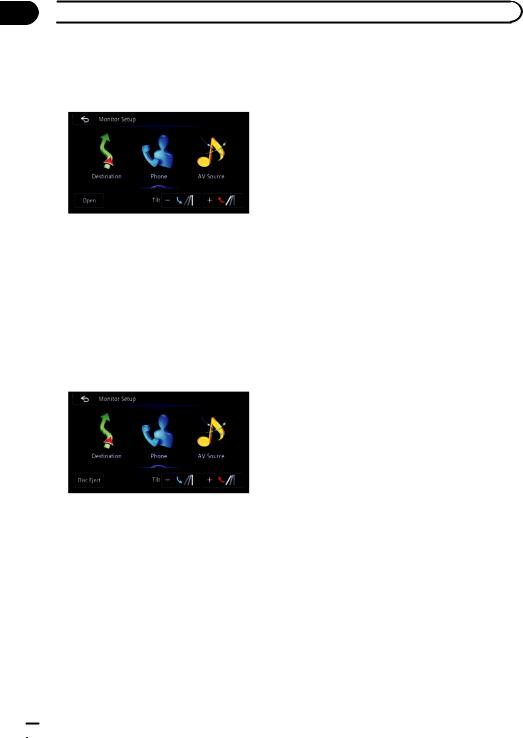
Chapter
02  Basic operation
Basic operation
1 Press the h button.
The “Monitor Setup” screen appears.
2 Touch [Open].
The LCD panel opens, and the disc-loading slot appears.
3 Insert a disc into the disc-loading slot.
The disc is loaded, and the LCD panel closes.
Ejecting a disc (for AVIC-Z150BH)
1 Press the h button.
The “Monitor Setup” screen appears.
2 Touch [Disc Eject].
The LCD panel opens, and the disc is ejected.
3 Remove the disc, and press the h button.
The LCD panel closes.
Inserting a disc (for AVIC-X950BH, AVIC-X850BT and AVIC-X8510BT)
 CAUTION
CAUTION
Do not insert anything other than a disc into the disc-loading slot.
% Insert a disc into the disc-loading slot.
Ejecting a disc (for AVIC-X950BH, AVIC-X850BT and AVIC-X8510BT)
% Press the h button.
The disc is ejected.
Inserting and ejecting an SD memory card
 CAUTION
CAUTION
!Ejecting an SD memory card during data transfer can damage the SD memory card. Be sure to eject the SD memory card by the procedure described in this manual.
!If data loss or corruption occurs on the storage device for any reason, it is usually not possible to recover the data. Pioneer accepts no liability for damages, costs or expenses arising from data loss or corruption.
!Do not insert anything other than SD memory cards.
pThis system is not compatible with the Multi Media Card (MMC).
pCompatibility with all SD memory cards is not guaranteed.
pThis unit may not achieve optimum performance with some SD memory cards.
Inserting an SD memory card (for AVIC-Z150BH)
 CAUTION
CAUTION
!Do not press the h button when an SD memory card is not fully inserted. Doing so may damage the card.
!Do not press the h button before an SD memory card has been completely removed. Doing so may damage the card.
1 Press and hold the h button.
The LCD panel opens fully.
 16
16 En
En
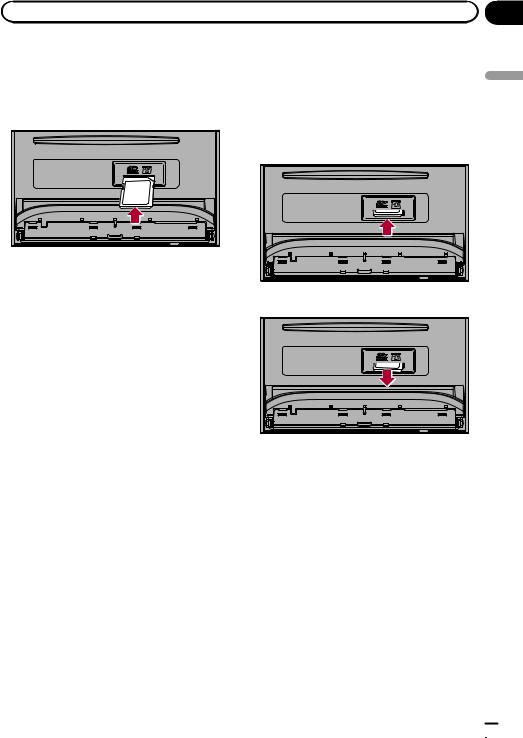
|
Chapter |
Basic operation |
02 |
2 Insert an SD memory card into the SD card slot.
Insert it with the label surface face-up and press the card until it clicks and completely locks.
3 Press the h button.
The LCD panel closes.
Ejecting an SD memory card (for AVIC-Z150BH)
1Press and hold the h button.
The LCD panel opens fully.
2Press the middle of the SD memory card gently until it clicks.
3 Pull the SD memory card out straight.
4 Press the h button.
The LCD panel closes.
Inserting an SD memory card (for AVIC-X950BH, AVIC-X850BT and AVIC-X8510BT)
% Insert an SD memory card into the SD card slot.
Insert the SD memory card with the terminal contacts face-down, and press the card until it clicks and locks completely.
operation Basic
En  17
17
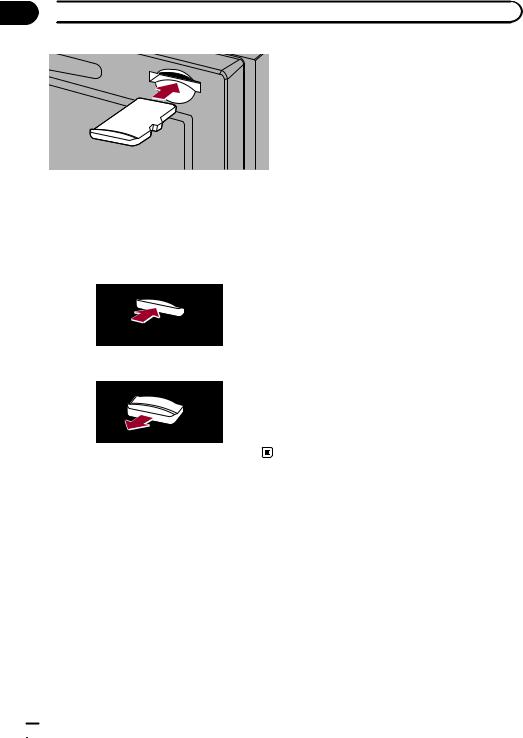
Chapter
02  Basic operation
Basic operation
Ejecting an SD memory card (for AVIC-X950BH, AVIC-X850BT and AVIC-X8510BT)
1 Press the middle of the SD memory card gently until it clicks.
2 Pull the SD memory card out straight.
Connecting and disconnecting an iPod
 CAUTION
CAUTION
!To prevent data loss and damage to the storage device, never remove it from this navigation system while data is being transferred.
!Pioneer cannot guarantee compatibility with all USB mass storage devices and assumes no responsibility for any loss of data on media players, iPhone, smartphone, or other devices while using this product.
Connecting your iPod
For iPod with 30-pin connector users
Using a USB interface cable for iPod / iPhone (CD-IU201N) (sold separately), you can connect your iPod to the navigation system.
p For details about iPod compatibility with this navigation system, refer to the information on our website.
p Connection via a USB hub is not possible.
For iPod with Lightning connector users who use a USB interface cable for iPod / iPhone
You can connect your iPod with this navigation system by using a USB interface cable for iPod / iPhone (CD-IU201N) (sold separately) and a Lightning to 30-pin Adapter (Apple Inc. products) (sold separately).
However, functions related to iPod video files are not available.
For iPod with Lightning connector users who use an HDMI/USB interface cable for iPod / iPhone (for AVICZ150BH and AVIC-X950BH)
To play music and/or video files on your iPod with this navigation system, connect the following cables, and launch CarMediaPlayer while in AppRadio Mode.
!HDMI/USB interface cable for iPod / iPhone (CD-IH202) (sold separately)
!Lightning Digital AV Adapter (Apple Inc. products) (sold separately)
!Lightning to USB cable (supplied with iPhone with Lightning connector)
=For details of AppRadio Mode, refer to Chapter 26.
=Refer to the CarMediaPlayer manual for more information.
 18
18 En
En
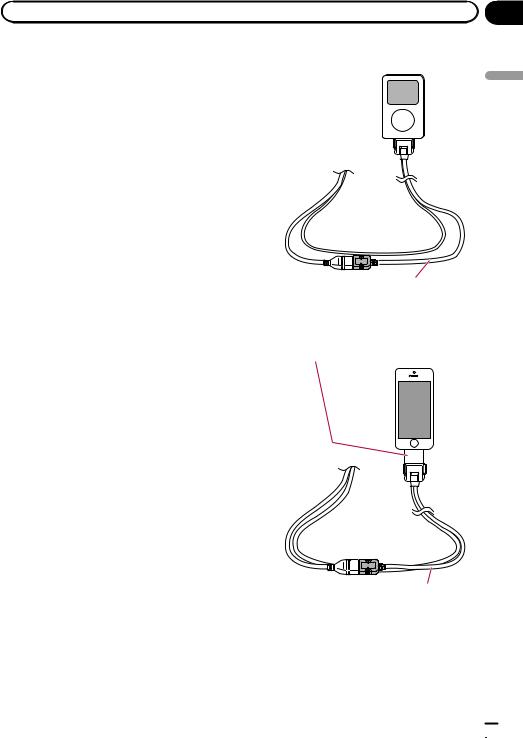
|
Chapter |
Basic operation |
02 |
For iPod with Lightning connector users who use a VGA/USB interface cable for iPod / iPhone (for AVICX850BT and AVIC-X8510BT)
To play music and/or video files on your iPod with this navigation system, connect the following cables, and launch CarMediaPlayer while in AppRadio Mode.
!VGA/USB interface cable for iPod / iPhone (CD-IV202NAVI) (sold separately)
!Lightning to VGA Adapter (Apple Inc. products) (sold separately)
!Lightning to USB cable (supplied with iPhone with Lightning connector)
=For details of AppRadio Mode, refer to Chapter 26.
=Refer to the CarMediaPlayer manual for more information.
1Check that no USB storage device is connected.
2Connect your iPod.
=For details of the operations, refer to the Installation Manual.
! For iPod with 30-pin connector users
operation Basic
USB interface cable for iPod / iPhone
!For iPod with Lightning connector users who use a USB interface cable for iPod / iPhone
Lightning to 30-pin Adapter
USB interface cable for iPod / iPhone
En  19
19
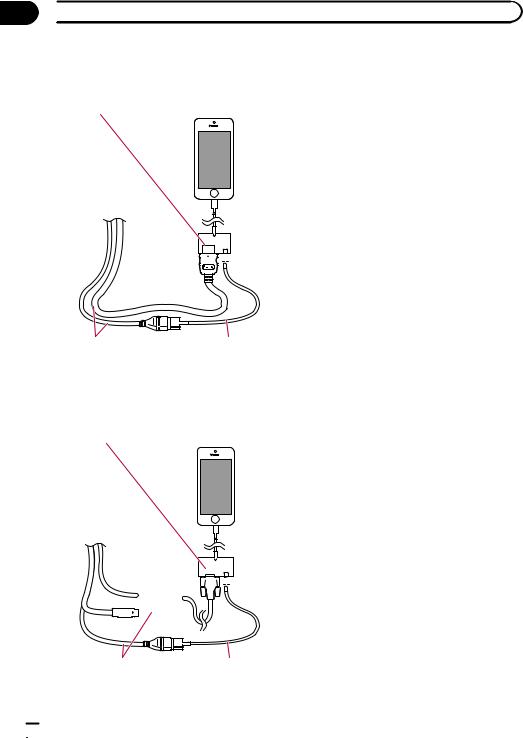
Chapter
02  Basic operation
Basic operation
!For iPod with Lightning connector users who use an HDMI/USB interface cable for iPod / iPhone (for AVIC-Z150BH and AVIC-X950BH)
Lightning Digital AV Adapter
Disconnecting your iPod
% Pull out the cables after confirming that no data is being accessed.
|
|
|
|
|
|
|
|
|
|
|
|
|
|
|
|
|
|
|
|
|
|
|
|
|
|
|
|
|
|
|
|
|
|
|
|
|
|
|
|
|
|
|
|
|
|
|
|
|
|
|
|
|
|
|
|
HDMI/USB interface |
|
Lightning to USB |
|||||
|
|||||||
|
|||||||
cable for iPod / |
|
|
|
|
|
|
cable |
iPhone |
|
|
|
|
|
|
|
!For iPod with Lightning connector users who use a VGA/USB interface cable for iPod / iPhone (for AVIC-X850BTand AVIC-X8510BT)
Lightning to VGA Adapter
Plugging and unplugging a USB storage device
 CAUTION
CAUTION
!To prevent data loss and damage to the storage device, never remove it from this navigation system while data is being transferred.
!Pioneer cannot guarantee compatibility with all USB mass storage devices and assumes no responsibility for any loss of data on media players, iPhone, smartphone, or other devices while using this product.
pThis navigation system may not achieve optimum performance with some USB sto-
rage devices.
p Connection via a USB hub is not possible.
pA USB interface cable for iPod / iPhone (sold separately) is required for connection. iPod with Lightning connector users can also connect a USB storage device to this navigation system by plugging it into the USB port of the other separately sold cable.
Plugging in a USB storage device
1 Pull out the plug from the USB port of the USB interface cable for iPod / iPhone.
|
|
|
|
|
|
|
|
|
|
|
|
|
|
|
|
|
|
|
|
|
|
|
|
|
|
|
|
|
|
|
|
|
|
|
|
|
|
|
|
|
|
|
|
|
|
|
|
|
|
|
|
|
|
|
|
|
|
|
|
|
|
|
|
|
|
|
|
|
|
|
|
|
|
|
|
|
|
|
|
|
|
|
|
|
|
|
|
|
|
|
|
|
|
|
|
|
|
|
|
|
|
|
|
|
|
|
|
|
|
|
|
|
|
|
|
|
|
|
|
|
|
|
Lightning to USB |
||||||||||||||
|
|
|
|
|
|
|
|
|||||||||||||||
|
|
|
|
|
|
|
|
|||||||||||||||
|
|
|
|
|
|
|
|
|||||||||||||||
|
|
|
|
|
|
|
|
|||||||||||||||
|
|
|
|
|
|
|
|
|||||||||||||||
VGA/USB interface |
||||||||||||||||||||||
cable for iPod / |
|
|
|
|
|
|
|
|
|
|
|
|
|
|
cable |
|||||||
iPhone |
|
|
|
|
|
|
|
|
|
|
|
|
|
|
|
|||||||
 20
20 En
En
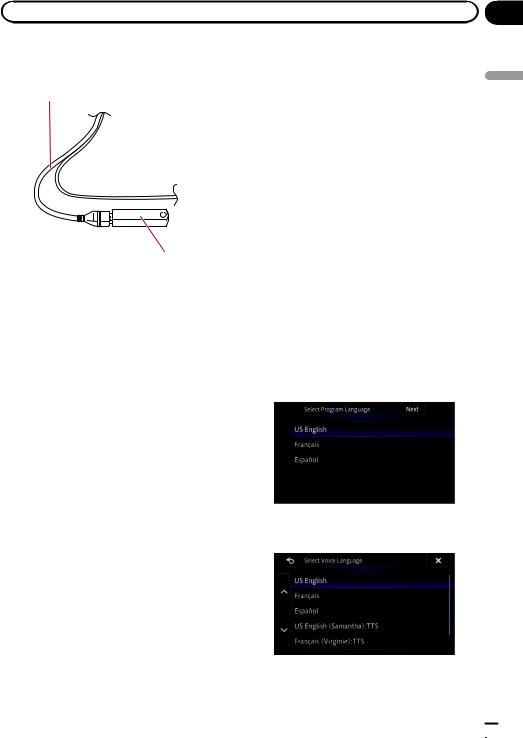
|
Chapter |
Basic operation |
02 |
2 Plug a USB storage device into the USB interface cable for iPod / iPhone.
USB interface cable for iPod / iPhone
Startup and termination
1Start the engine to boot up the system.
After a short pause, the splash screen comes on for a few seconds.
p To protect the LCD screen from damage, be sure to touch the touch panel keys only with your finger and do so gently.
2Turn off the vehicle engine to termi-
nate the system.
The navigation system is also turned off.
operation Basic
USB storage device
Unplugging a USB storage device
% Pull out the USB storage device after checking that no data is being accessed.
On first-time startup
When you use the navigation system for the first time, select the language that you want to use.
1Start the engine to boot up the system.
After a short pause, the splash screen comes on for a few seconds.
2Touch the language that you want to use on screen.
3 Touch the language that you want to use for the voice guidance.
The navigation system will now restart.
En  21
21
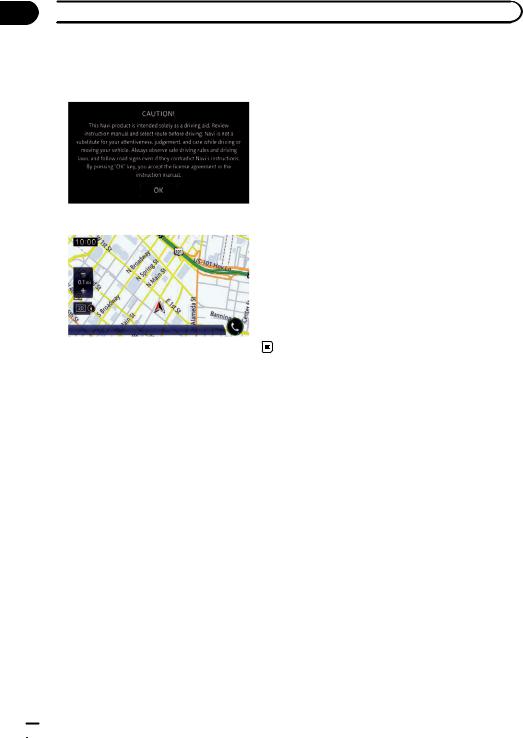
Chapter
02  Basic operation
Basic operation
4 Read the terms carefully, checking the details, and then touch [OK] if you agree to the conditions.
A message about the map database
After you start using this navigation system, a message related to map data may be displayed.
p This message is displayed the first time you turn on the navigation system each month.
pTouch the message to close it or it will dis-
appear automatically after eight seconds.
The map screen appears.
Demonstration images
If you do not operate this navigation system for five minutes, demonstration images are displayed.
p The demonstration images will not be displayed if you drive after mounting this navigation system.
Regular startup
% Start the engine to boot up the system.
After a short pause, the splash screen comes on for a few seconds.
pThe screen shown will differ depending on the previous conditions.
pIf the anti-theft function is activated, you must enter your password.
pThe terms appear if the previous condition was the navigation screen.
Read the terms carefully, checking the details, and then touch [OK] if you agree to the conditions.
After you touch [OK], the screen that was displayed just before turning off the ignition switch (ACC OFF) is displayed.
Temporarily clearing the screen (navigation system in standby mode)
You can temporarily clear the screen at night or when the screen is too bright.
% Press and hold the MAP button.
The screen is cleared temporarily.
pIf you touch the screen when the navigation system is in standby mode, it reverts to the original screen.
Also, if you press the MAP button, the standby mode is canceled and the current location screen is displayed. If you press the MODE button, the standby mode is canceled and the AV source screen is dis-
played.
p When the navigation system is in standby mode, the navigation guidance does not output the voice guidance. The audio sound is output.
pThe standby mode is not canceled by turning ignition switch on or off.
 22
22 En
En

|
Chapter |
Basic operation |
02 |
operation Basic
En  23
23
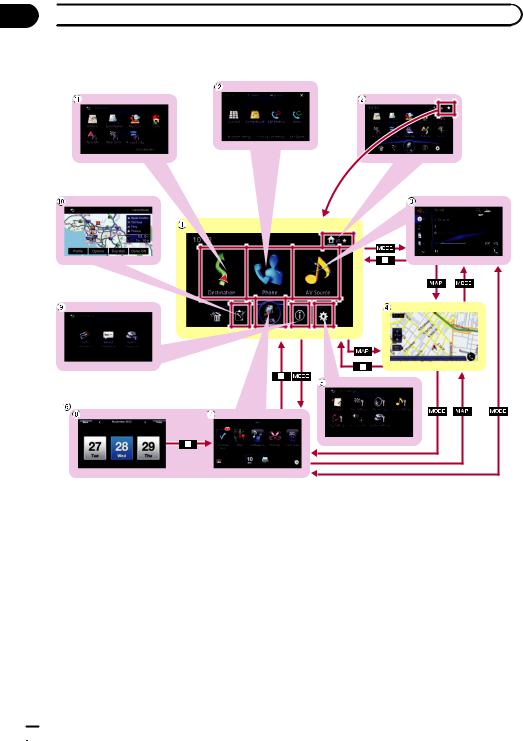
Chapter
02  Basic operation
Basic operation
How to use the navigation menu screens
1Top Menu
This is the starting menu to access the desired screens and operate various functions. You can also check or cancel your set route from this menu.
p If you press the HOME button, the screen of either “Top Menu” or Shortcut Menu which was being displayed last time is displayed.
p [Apps] is only available when an iPhone or a smartphone is connected to this navigation system.
2Shortcut Menu
p If you press the HOME button, the screen of either “Top Menu” or Shortcut
Menu which was being displayed last time is displayed.
3AV operation screen
This is the screen that normally appears when you play the AV source.
4Map screen
You can use this screen to check the current vehicle position information and route to the destination.
5Edit/Settings screen
You can access the screen to customize settings.
6AppRadio Mode screen
 24
24 En
En
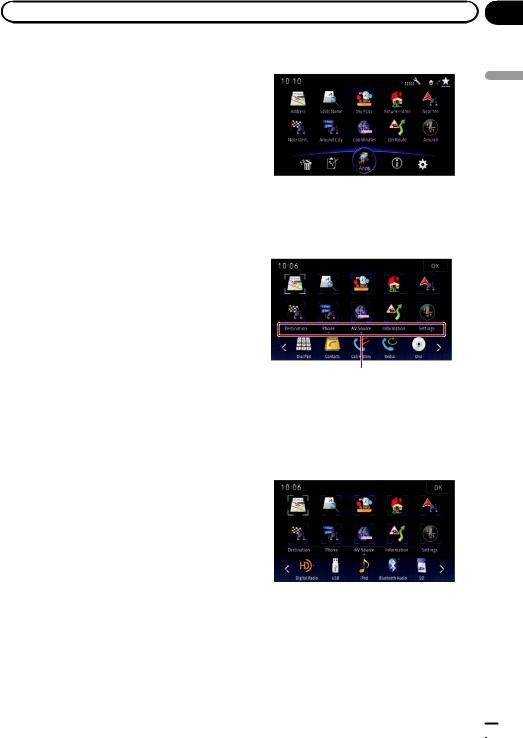
|
Chapter |
Basic operation |
02 |
In this manual, the application menu screen and the application operation screen are collectively referred to as the “AppRadio Mode screen”.
7Application menu screen
This navigation system can switch to the application menu, which you can display and operate the application for the iPhone or smartphone on the screen.
8Application operation screen
You can control the iPhone or smartphone applications directly on the navigation screen.
9Information screen
You can access the screen for handling various information such as the system informa-
tion of the device.
aEditing route screen
You can edit the conditions for calculating the current route.
bDestination screen
You can search for your destination on this menu.
cPhone screen
You can access the screen that is related to hands-free phoning.
Shortcut Menu
Registering your favorite menu items in shortcuts allows you to quickly jump to the registered menu screen by a simple touch on the Shortcut Menu screen.
Selecting the shortcut
pUp to 10 menu items can be registered in shortcuts.
1Display the Shortcut Menu screen.
=For details of the operations, refer to How to use the navigation menu screens on page 24.
2 Touch  .
.
The Shortcut selection screen appears. |
operation Basic |
|
3 Touch the tab or touch  or
or  to display the icon that you want to set to shortcut.
to display the icon that you want to set to shortcut.
Tabs
4Touch and hold the icon that you want to add to shortcut.
5Move the icon to the upper side of the screen, and then release it.
The selected item is added to shortcut.
Removing a shortcut
1Touch and hold the icon of the shortcut you want to remove.
2Move the icon to the lower side of the screen, and then release it.
En  25
25
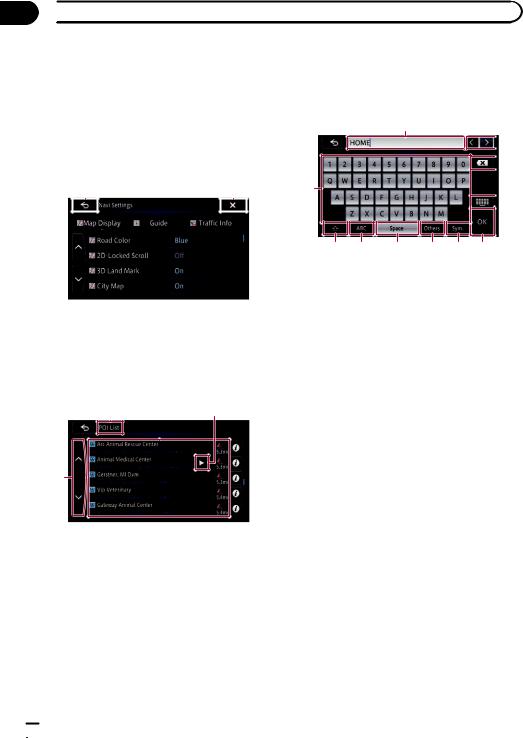
Chapter
02  Basic operation
Basic operation
Using the touch panel |
right of the item allows you to see the remain- |
You can operate the product by touching the |
ing characters. |
|
|
marks and items (touch panel keys) displayed |
Operating the on-screen keyboard |
on the screen directly with your fingers. |
|
|
b |
Using the common touch panel keys
1 |
2 |
|
|
|
|
|
|
|
1
The previous screen returns.
2
The screen is closed.
Operating list screens (e.g. POI list)
2 3 4
1
1

Touching  or
or  on the scroll bar scrolls through the list and allows you to view the re-
on the scroll bar scrolls through the list and allows you to view the re-
maining items.
2Screen title
3Listed items
Touching an item on the list allows you to narrow down the options and proceed to the next operation.
4

 a
a  9
9
1
 8
8
2 3 4 5 6 7
1Keyboard
Touching the keys enters the characters in the text box.
2
You can switch between capital and lower case letters.
3ABC
You can enter letters and numbers.
4Space
You can leave spaces.
A space equivalent to the number of touches is inserted.
5Others
You can enter other characters of alphabet. p Even if you use any of “A”, “Ä”, “Å”, “Æ”,
the displayed result is the same.
6Sym.
You can enter text with marks such as “&”, “+”, or numbers.
7OK
Confirms the entry and allows you to proceed to the next step.
8
Switches the on-screen keyboard layout.
9
Deletes the input text one letter at a time, beginning at the end of the text. Continuing to touch the key deletes all of the text.
If not all the characters can be displayed within the displayed area, touching the key to the
 26
26 En
En
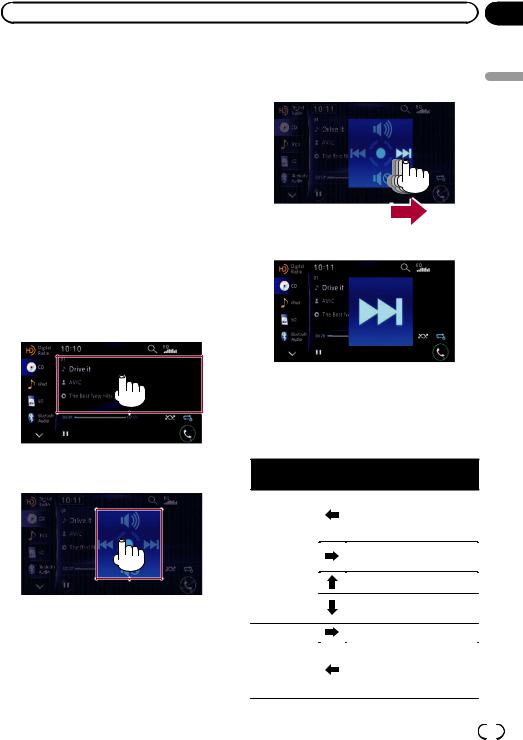
|
Chapter |
Basic operation |
02 |
a
Allows you to move the cursor to the right or left for a number of characters equivalent to the number of touches.
bText box
Displays the characters that are entered. If
there is no text in the box, an informative guide with text appears.
Swipe action
You can operate some navigation and audio functions by sliding your fingers vertically and horizontally while touching the screen.
1 Touch and hold the swipe response area.
pThe swipe response area varies depending on the displayed screen.
Example: CD
2 While touching the screen, slide your finger toward the function you want to execute and release.
j
operation Basic
Swipe response area
j
Operation guide
The operation guide appears.
The selected function is zoomed in and the function operates.
Swipe action list
Navigation
Operation
Action
screen
|
|
Displays the turning direction |
|
|
|
|
|
at the next guide point and |
|
|
|
|
|
the distance, and gives a |
|
|
|
|
|
voice announcement. |
|
|
|
Guidance dis- |
|
|
|
|
|
|
Cancels the display of the in- |
|
|
|
|
play |
|
tersection guide map. |
|
|
|
|
|
|
|
|
|
|
|
Hides the street list. |
|
|
|
|
|
|
|
|
|
|
|
Displays the next guidance |
|
|
|
|
|
point. |
|
|
|
|
|
|
|
|
|
The auto re- |
|
Selects an alternative route. |
|
|
|
route function |
|
|
|
|
|
|
|
|
|
|
|
taking into ac- |
|
|
|
|
|
count traffic |
|
Selects the current route. |
|
|
|
congestion |
|
|
|
|
|
|
|
|
|
|
|
(*1) |
|
|
|
|
|
|
|
|
|
|
|
|
|
|
|
||
|
|
En |
|
27 |
|
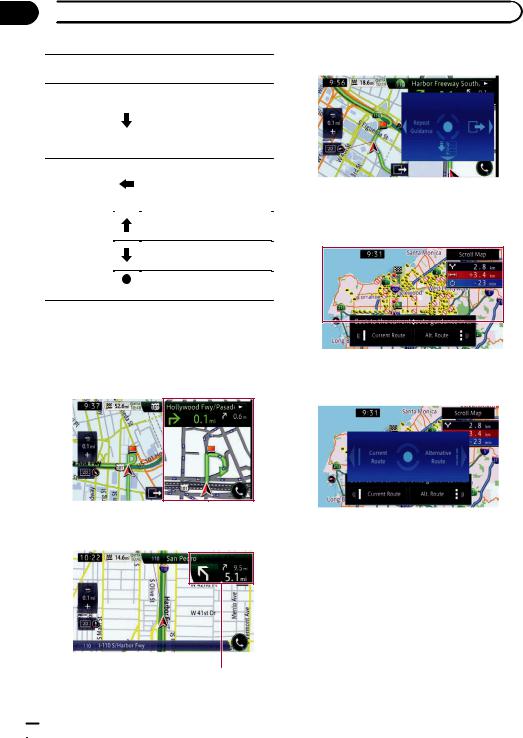
Chapter
02  Basic operation
Basic operation
Operation |
Action |
||
screen |
|||
|
|
||
|
|
|
|
The auto re- |
|
|
|
route function |
|
|
|
taking into ac- |
|
Restarts the route guidance of |
|
count closed/ |
|
an alternative route. |
|
blocked roads |
|
|
|
(*1) |
|
|
|
|
|
|
|
|
|
Displays the turning direction |
|
|
|
at the next guide point and |
|
|
|
the distance, and gives a |
|
|
|
voice announcement. |
|
|
|
|
|
App View |
|
The sound mix function is dis- |
|
|
abled. |
||
map |
|
||
|
|
||
|
|
The sound mix function is en- |
|
|
|
abled. |
|
|
|
|
|
|
(*2) |
Displays the “AppRadio |
|
|
Mode” screen. |
||
|
|
|
|
(*1) This function is available on AVIC-Z150BH and AVIC-X950BH.
(*2) Displays this screen after releasing your finger from the circle.
!The intersection guidance display and the interchange guidance display
j
!The auto reroute function taking into account traffic congestion (for AVIC-Z150BH and AVIC-X950BH)
Swipe response area
j
Swipe response area
The other guidance displays
Swipe response area
 28
28 En
En
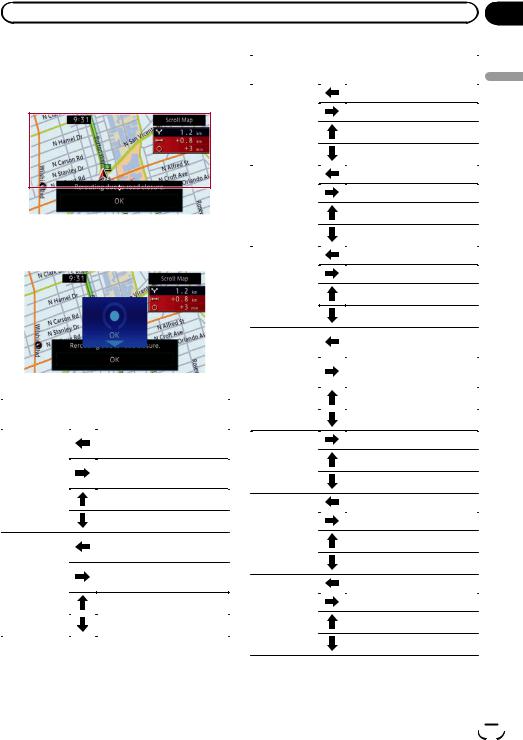
|
Chapter |
Basic operation |
02 |
!The auto reroute function taking into account closed/blocked roads (for AVICZ150BH and AVIC-X950BH)
Swipe response area
j
Audio
Operation |
Action |
||
screen |
|||
|
|
||
|
|
|
|
|
|
Skips to the previous preset |
|
|
|
channel. |
|
|
|
|
|
Radio (FM, |
|
Skips to the next preset chan- |
|
|
nel. |
||
AM) (*1) |
|
||
|
|
||
|
Unmutes the sound. |
||
|
|
||
|
|
|
|
|
|
Mutes the sound. |
|
|
|
|
|
|
|
Skips to the previous preset |
|
|
|
channel. |
|
|
|
|
|
HD Radio |
|
Skips to the next preset chan- |
|
(HD Radio™ |
|
nel. |
|
tuner) (*2) |
|
Unmutes the sound. |
|
|
|
||
|
|
|
|
|
|
Mutes the sound. |
|
|
|
|
|
Operation |
Action |
|
||
screen |
|
|||
|
|
|
||
|
|
|
|
Basic |
|
|
|
Skips to the previous track. |
|
R, CD-RW)/ |
|
|
||
Disc (CD, CD- |
|
Skips to the next track. |
|
|
|
|
|
|
|
Bluetooth |
|
|
operation |
|
|
Unmutes the sound. |
|||
Audio |
|
|
|
|
|
Mutes the sound. |
|
||
|
|
|
|
|
|
|
|
|
|
|
|
|
Skips to the previous chapter. |
|
|
|
|
|
|
Disc (DVD- |
|
Skips to the next chapter. |
|
|
|
|
|
||
|
|
|
||
Video) |
|
Unmutes the sound. |
|
|
|
|
|
|
|
|
|
|
Mutes the sound. |
|
|
|
|
|
|
|
|
|
Skips to the previous file. |
|
|
|
|
|
|
Disc (DivX |
|
Skips to the next file. |
|
|
video files)/ |
|
Unmutes the sound. |
|
|
SD/USB |
|
|
||
|
|
|
||
|
|
|
Mutes the sound. |
|
|
|
|
|
|
|
|
|
Skips to the previous chapter |
|
|
|
|
or song. |
|
|
|
|
|
|
|
|
|
Skips to the next chapter or |
|
iPod |
|
song. |
|
|
|
|
|
Unmutes the sound. |
|
|
|
|
|
|
|
|
|
Mutes the sound. |
|
|
|
|
|
|
|
|
|
Skips to the next track. |
|
|
|
|
|
|
Pandora® |
|
Unmutes the sound. |
|
|
|
|
|
Mutes the sound. |
|
|
|
|
|
|
|
|
|
Skips to the previous content. |
|
|
|
|
|
|
|
|
|
Skips to the next content. |
|
Aha Radio |
|
|
|
|
|
Unmutes the sound. |
|
||
|
|
|
|
|
|
|
|
|
|
|
|
|
Mutes the sound. |
|
|
|
|
|
|
|
|
|
Skips to the previous channel. |
|
|
|
|
|
|
SiriusXM™ |
|
Skips to the next channel. |
|
|
|
|
|
||
tuner |
|
Unmutes the sound. |
|
|
|
|
|
|
|
|
|
|
Mutes the sound. |
|
|
|
|
|
|
(*1) A source available on AVIC-X850BT and AVICX8510BT.
(*2) A source available on AVIC-Z150BH and AVICX950BH.
En  29
29
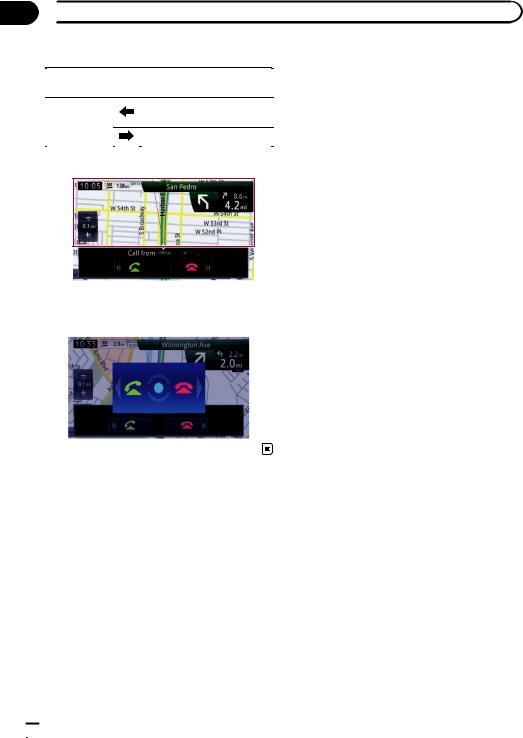
Chapter
02  Basic operation
Basic operation
Hands-free phoning
Operation |
Action |
||
screen |
|||
|
|
||
|
|
|
|
Receiving a |
|
Allows you to talk on the |
|
|
phone. |
||
phone call |
|
|
|
|
Ends the call. |
||
|
|
||
|
|
|
|
! Receiving a phone call
Swipe response area
j
 30
30 En
En
